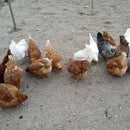Introduction: Rain Barrel Waterer Using a Float Valve
I have 21 chickens and seven goats that drink a lot of water on summer days. During the day the chickens run loose with the goats and they all drink from the same water source. I had been filling a small trough a couple times a day with a hose from a well pump. There were times that the trough would run dry and I wasn't around to fill it and the animals definitely need water.
My solution to fixing this problem was to connect the rain barrel with a garden hose to a float valve device mounted on the trough. The rain barrel is in the chicken run and gets its water from a downspout on the chicken coop. I simply run a hose from the hose bib on the rain barrel to the trough that is sitting outside the chicken run. Since the chickens were let loose on most days, they could get to the trough as well as the goats could. I also kept a waterer inside the coop for the days when they weren't let out. I hated having to clean and fill the one in the coop so I eventually set up a second float waterer inside the run using a splitter connected to the hose bib.
This isn't much of a tutorial but does illustrate a solution to a very practical problem. It took me a while to come up with a simple solution that should have been obvious from the beginning. I had known about the float valve but I always associated it with connecting it to well pump and I didn't want risk having that pump turned on when I wasn't around. Then it occurred to me that I could hook it up to a rain barrel. If the water ran dry and there was not rain, I could always fill it from the well.
Parts needed:
Guttering system and downspout to collect water from a roof
Food grade rain barrel or some alternative container
Hose bib
hose splitter
Two garden hoses
Two Little Giant® Trough-O-Matic™ Plastic Float Valve from Tractor Supply (http://www.tractorsupply.com/en/store/little-giantreg%3B-trough-o-matictrade%3B-plastic-float-valve?cm_vc=-10005)
Two containers to hold the water
The accompanying photos illustrate the setup.
My solution to fixing this problem was to connect the rain barrel with a garden hose to a float valve device mounted on the trough. The rain barrel is in the chicken run and gets its water from a downspout on the chicken coop. I simply run a hose from the hose bib on the rain barrel to the trough that is sitting outside the chicken run. Since the chickens were let loose on most days, they could get to the trough as well as the goats could. I also kept a waterer inside the coop for the days when they weren't let out. I hated having to clean and fill the one in the coop so I eventually set up a second float waterer inside the run using a splitter connected to the hose bib.
This isn't much of a tutorial but does illustrate a solution to a very practical problem. It took me a while to come up with a simple solution that should have been obvious from the beginning. I had known about the float valve but I always associated it with connecting it to well pump and I didn't want risk having that pump turned on when I wasn't around. Then it occurred to me that I could hook it up to a rain barrel. If the water ran dry and there was not rain, I could always fill it from the well.
Parts needed:
Guttering system and downspout to collect water from a roof
Food grade rain barrel or some alternative container
Hose bib
hose splitter
Two garden hoses
Two Little Giant® Trough-O-Matic™ Plastic Float Valve from Tractor Supply (http://www.tractorsupply.com/en/store/little-giantreg%3B-trough-o-matictrade%3B-plastic-float-valve?cm_vc=-10005)
Two containers to hold the water
The accompanying photos illustrate the setup.




